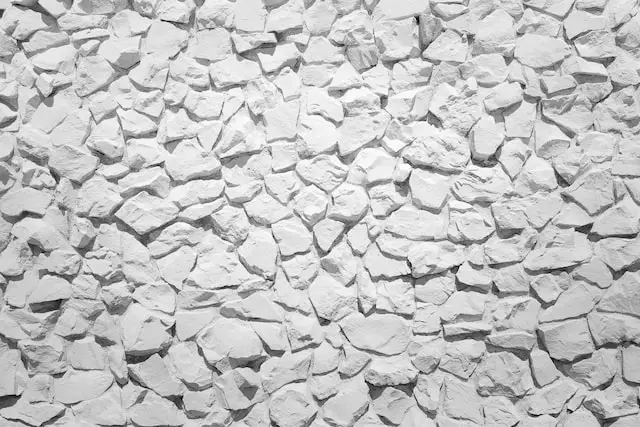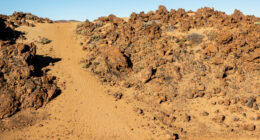Dolomite is known for its hardness and strength, which makes it ideal for building materials such as concrete aggregates. It also has several industrial uses like manufacturing steel, glass production and soil pH control while limestone is widely used in the construction industry due to its durability and versatility.
Dolomite
(photo By James St. John on flickr)

Dolomite is a type of sedimentary rock that’s composed mainly of calcium and magnesium carbonate. It often forms in marine environments, where the accumulation of dead shells and other organic matter leads to the development of thick deposits over time.
One unique property that sets dolomite apart from limestone is its slightly pink or gray hue. This coloration results from small amounts of iron present in the rocks. Another key difference between dolomite and limestone is their solubility in acid – while limestone dissolves readily when exposed to acids like vinegar, dolomite remains relatively insoluble.
Despite being less soluble than limestone, dolomite still has many practical uses. For instance, it’s commonly used as an additive for soil fertilizers due to its high levels of magnesium and calcium content. Dolomite is also used in construction materials like concrete and asphalt because it can provide strength without adding much weight.
In addition to these applications, some people believe that consuming dolomite supplements can have health benefits such as reducing inflammation and relieving muscle pain. However, it’s important to consult with a healthcare professional before taking any dietary supplements containing this mineral.
Limestone
(Photo by Kenny Eliason on Unsplash )

Limestone is a sedimentary rock made up mostly of calcium carbonate. It forms from the accumulation of shells, coral, and other debris that settle on the ocean floor. Over time, these materials become compacted and cemented together to form limestone.
One of the most notable characteristics of limestone is its natural beauty. It comes in a variety of colors, including white, gray, beige, and even pink. This makes it an attractive building material for everything from homes to cathedrals.
In addition to its aesthetic appeal, limestone also has practical uses. For example, it’s commonly used as a base material for roads and highways due to its strength and durability. Limestone can also be crushed into smaller pieces and used as aggregate in concrete or asphalt.
Another benefit of limestone is its ability to neutralize acid rain and other acidic pollutants in soil and water. This makes it an important component in environmental cleanup efforts around the world.
There are many reasons why limestone is such a valuable resource. From construction to conservation efforts, this versatile rock plays an important role in our daily lives.
Dolomite Vs. Limestone – Key differences
Dolomite and limestone are sedimentary rocks that share some similarities but also have distinct differences. The main difference between dolomite and limestone is their mineral composition. Limestone mostly consists of calcium carbonate, while dolomite is a mixture of calcium magnesium carbonate.
Another key difference between the two rocks can be seen in their appearance. Limestone tends to be light-colored, ranging from white to gray or even yellowish-brown. Dolomite, on the other hand, typically has a more pinkish hue and may include streaks or patches of white.
In terms of hardness, dolomite is generally harder than limestone due to its higher density and greater durability. This makes it better suited for use as construction material in high-stress applications such as road building or concrete production.
While both rocks have similar uses in construction and agriculture, there are some notable differences in their properties that make them better suited for certain applications. For example, lime derived from limestone is commonly used as an agricultural soil treatment due to its high calcium content. Meanwhile, dolomitic lime – made from dolomite – contains both calcium and magnesium which can improve plant growth even further.
Understanding the differences between these two common sedimentary rocks can help you choose the right material for your specific project needs whether it’s construction or farming related.
Is dolomite stronger than limestone?
When it comes to strength, dolomite and limestone have different properties. Dolomite is generally considered to be stronger than limestone because it has a higher density and hardness rating on the Mohs scale. However, both rocks are still relatively soft compared to other stones like granite or quartzite.
The strength of a rock depends on various factors such as its mineral composition, porosity, texture, and formation process. In terms of mineral composition, dolomite contains more magnesium than calcium while limestone is mostly composed of calcium carbonate. This difference in mineral content gives dolomite its characteristic pinkish-gray color and slightly harder surface.
Moreover, the formation process of each rock also affects their overall strength. Limestone forms from sedimentary deposits that have been compacted over time whereas dolomite forms when magnesium-rich fluids interact with existing limestone deposits. This means that dolomite may have undergone additional pressure during its formation which contributes to its higher density and hardness rating.
While dolomite is technically stronger than limestone due to its higher density and hardness rating, both rocks are still relatively soft compared to other stones like granite or quartzite.
What is dolomite used for?
Dolomite is a versatile mineral that has many uses in various industries. One of its most common applications is as a source of magnesium, which is extracted from dolomite for use in the production of refractory bricks, fertilizers, and other chemical compounds.
Apart from this, dolomite also finds use as an ornamental stone in construction projects such as countertops and flooring tiles. Its unique coloration and patterning make it an attractive addition to any home or office space.
In agriculture, dolomitic lime – a type of soil conditioner made from pulverized dolomite rock – is used to raise pH levels in acidic soils. This helps improve plant growth by making essential nutrients more available to roots.
The steel industry also relies on high-quality dolomite for producing fluxes needed during the manufacturing process. These fluxes help remove impurities from molten iron and steel before they are poured into molds or rolled out into sheets.
The versatility of dolomite makes it an indispensable mineral across different fields today.
What is limestone used for?
Limestone is a versatile rock that has been used for various purposes throughout history. One of the primary uses of limestone is in construction. It is commonly used as a building material and can be found in everything from statues and monuments to buildings and bridges.
In addition to its use as a construction material, limestone is also used in agriculture. Limestone can help balance soil pH levels which allows plants to grow better. It is also commonly added to animal feed as it provides essential nutrients such as calcium.
Another use for limestone is in the manufacturing industry. Limestone can be crushed into a fine powder known as calcium carbonate which has numerous applications including being used as an ingredient in toothpaste, paint, and plastic.
Furthermore, limestone has decorative uses like flooring tiles or countertops due to its unique patterns formed by natural sedimentation over time.
The versatility of limestone makes it one of the most widely-used rocks on earth with significant contributions across various industries besides architecture such as agriculture, manufacturing among others.
What are the benefits of dolomite?
Dolomite is a mineral that has been used for various purposes throughout history. Here are some of the benefits of dolomite:
- Improves soil quality- Dolomite contains calcium and magnesium, which can help to improve soil acidity levels by neutralizing acidic soils.
- Promotes healthy plant growth- The minerals found in dolomite can also aid in plant growth, promoting stronger stems and healthier leaves.
- Provides essential nutrients- Dolomite is a natural source of calcium and magnesium, both essential minerals for human health. Consuming dolomite supplements may provide these nutrients to support bone density and muscle function.
- Used as an additive- Dolomite is commonly added to cement mixtures as it can act as a binding agent. It’s also used in glass production due to its high melting point.
- Aids in water treatment- Its alkaline nature means that it can be used in water treatment processes to balance pH levels.
The benefits of dolomite extend beyond just construction materials or decorative uses – this versatile mineral offers many advantages across several industries.
What are the benefits of limestone ?
Limestone is a versatile sedimentary rock that has numerous benefits, making it a popular choice in various industries. One of the significant advantages of limestone is that it is abundant and widely available worldwide.
In construction, limestone’s durability and availability make it an excellent material for building homes, bridges, roads, and other structures. The rock’s natural beauty also makes it a favorite choice for architectural designs.
Limestone also has several industrial uses due to its chemical properties. It can be heated to create lime or calcium oxide used in cement manufacturing and steel production. Additionally, limestone-derived products like quicklime are used as pH stabilizers in water treatment facilities.
Another benefit of limestone lies in its agricultural use where farmers use crushed limestone to improve soil quality by reducing acidity levels. This helps plants grow better while preventing soil erosion caused by wind or rainwater runoff.
In summary, the benefits of using Limestone are numerous from construction projects to agriculture industry all over the world. It remains one of nature’s most useful resources due to its versatility and abundance.
Featured Image By – LoggaWiggler from Pixabay








